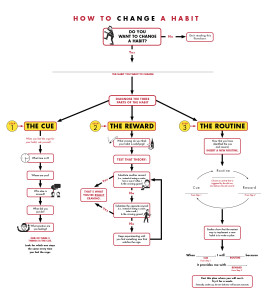
Build New Habits to Insure You Meet Your Goals
The problem with goals is that most of them are too big, and they take a long time, and that requires work. That’s also what makes them worthwhile! But on a day-to-day basis, you need to figure out how to build the habits that will eventually get you to your goals.
Charles Duhigg wrote a great book on how to break bad habits and build better ones – The Power of Habit. Here is his flow chart for building habits (click on the image to see it full-size):
> If your goal is to lose weight, you need to change your eating (input) and exercise (output) habits.
> If your goal is to write a book, you need to change your writing habits.
Austin Kleon wrote a great post on breaking goals down into habits. He says to do something small, every day:
Figure out what your little daily chunk of work is, and every day, no matter what, make sure it gets done.
Don’t say you don’t have enough time. We’re all busy, but we all get 24 hours a day. People often ask me, “How do you find the time for the work?” And I answer, “I look for it.” You find time the same place you find spare change: in the nooks and crannies. You find it in the cracks between the big stuff—your commute, your lunch break, the few hours after your kids go to bed. You might have to miss an episode of your favorite TV show, you might have to miss an hour of sleep, but you can find the time to work if you look for it.
What I usually recommend: get up early. Get up early and work for a couple hours on the thing you really care about. When you’re done, go about your day…
Do the work every day. Fill the boxes on your calendar. Don’t break the chain.
This approach works pretty well for most of our personal goals. But what if our goal is to make our organizations more innovative?
That’s a bit trickier. The main reason is that innovation is a lot more complex. Complex systems are trickier because they require us to approach our goals indirectly. This excerpt from John Kay’s terrific book Obliquity outlines the issue:
If you want to go in one direction, the best route may involve going in the other. Paradoxical as it sounds, goals are more likely to be achieved when pursued indirectly. So the most profitable companies are not the most profit-oriented, and the happiest people are not those who make happiness their main aim. The name of this idea? Obliquity.
Obliquity is relevant whenever complex systems evolve in an uncertain environment, and whenever the effect of our actions depends on the ways in which others respond to them.
Innovation is another thing that we need to approach obliquely. So what habits should we build to help? Here are some ideas that I’ve run across in the past couple of days:
- Take care of yourself. Jason Cohen points out that we are happier and more productive when we get enough sleep, exercise, and take time to think.
- Practice divergent thinking. It’s a mistake to jump straight to solutions when we’re trying to innovate. First, we have to explore a broad range of ideas. Olaf Kowalik writes about how to use divergent thinking to do this – and this is a key innovation skill.
- Read widely. Jorge Barba makes an important point at the end of his post recommending some innovation books to read:
One more thing: everything is connected in some way, so read about anything and everything. Not just books that have “innovation” in the title.
To innovate, you need the process, but you also need to muddle your way through a bit. So some of the habits you need to build are oblique – like getting enough sleep. Others are more direct, like blocking out time for thinking and allocating resources for building your ideas.
The main point is that things that are worth doing take effort over an extended period of time.
You need to build habits that will ensure that you make that effort.
Read more from Tim here.

Tags: Innovation, Tim Kastelle, habits, ministry innovation













